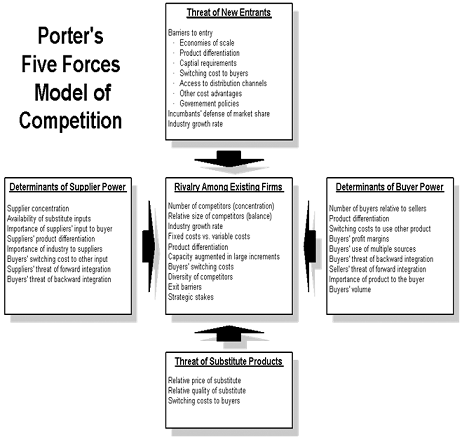- Business Concepts ›
- Marketing and Strategy ›
- Porter Five Forces Model
Porter Five Forces Model
Definition & Importance
This article covers meaning & overview of Porter Five Forces Model from marketing perspective.
What is meant by Porter Five Forces Model?
Porter five forces model is a strategy model proposed by Porter which provides a framework for assessing and analysing the competitive strength and position of a company, Porter five forces model is based on 5 parameters of an organization. The five forces defined by Porter are based on competitive rivalry, threats from new players, bargaining power of buyers & suppliers and substitute products.
Importance of Porter Five Forces Model
Porter five forces model is important to any business as it help them understand their business from a competition as well as market dynamics perspective. Porter five forces model is one of the many market analysis framework tools which gives a company a sense on their position and standing in the market vis-a-vis competitors. The different elements of Porter five forces elaborate a companies position versus its competitors, future competition, power of buyers as well as suppliers, and also the potential threat from new products. Companies also use tools like SWOT analysis & PEST analysis.
Elements of Porter Five Forces
The five forces defined by Porter can be explained as below:
1. Existing competitive rivalry between suppliers:
The first of the Porter five forces is the existing competition in the market. It comprises of the competitors to an organization present in the market.
2. Threat of new market entrants:
The second of Porter five forces highlights the possibility of new products being launched. It comprises of the ease with which new competitors can enter in the market. If it is easy for the new competitors to enter in the market, it poses a constant threat to the existing players.
3. Bargaining power of suppliers:
The third type in the Porter five forces tells about the power which suppliers possess. It implies the extent to which the industry is dependent on the suppliers for its operation. If the dependence is high and number of suppliers is less, suppliers enjoy considerable bargaining power in the industry.
4. Bargaining power of buyers:
Bargaining power of a buyer is more if he enjoys considerable market share in an industry. Using his bargaining power, he enjoys lower prices from suppliers and better quality. This is the fourth element in the Porter five forces.
5. Threat of substitutes
Substitute products are the fifth element in the Porter five forces. These are the products or services which are introduced in the market to replace the existing product or service in the market by offering lowered prices, better quality or sometimes both.
Example: -

The above diagram shows the various elements of Porter five forces model.
Hence, this concludes the definition of Porter Five Forces Model along with its overview.
This article has been researched & authored by the Business Concepts Team which comprises of MBA students, management professionals, and industry experts. It has been reviewed & published by the MBA Skool Team. The content on MBA Skool has been created for educational & academic purpose only.
Browse the definition and meaning of more similar terms. The Management Dictionary covers over 1800 business concepts from 5 categories.
Continue Reading:
What is MBA Skool?About Us
MBA Skool is a Knowledge Resource for Management Students, Aspirants & Professionals.
Business Courses
Quizzes & Skills
Quizzes test your expertise in business and Skill tests evaluate your management traits
Related Content
All Business Sections
Write for Us